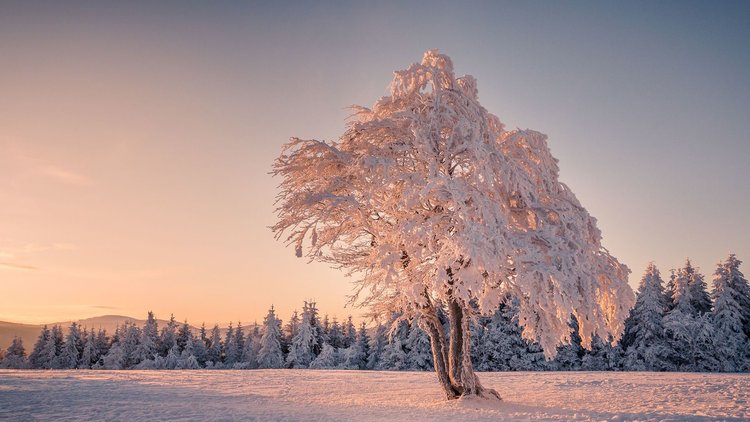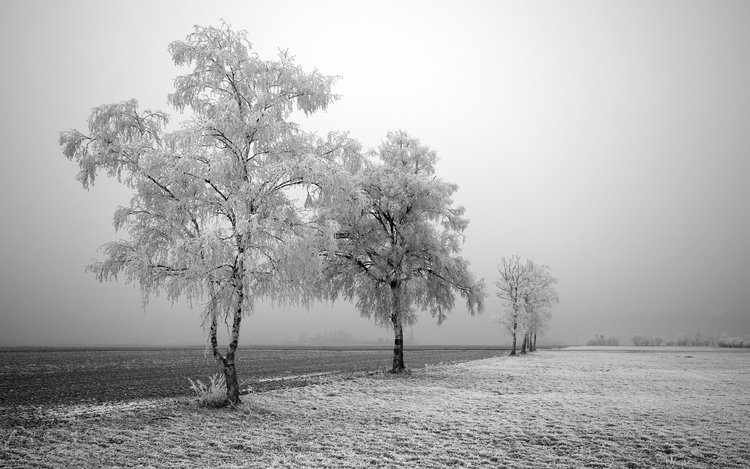How do Trees Survive Winter?

Trees, like all plants, are alive and require nutrients to survive. But what happens to trees during the winter, and how do they survive the frigid cold? If trees consist of water, what keeps the water from freezing, expanding, and even damaging the tree like bursting pipes during the coldest months of the year? As a tree and landscaping company, trees are more than just our business—they are our passion, and we have lot of respect for their amazing abilities to thrive and stay alive when the odds are stacked against them.
Because they can’t uproot themselves and migrate south to warmer clients like certain animals, trees enter a dormant state similar to the hibernation of snakes, bees, skunks, bears and bats (to name a few). This dormancy is what allows trees to survive the cold winter.
During dormancy, a tree’s metabolism, energy consumption, and growth all slow down significantly in order to endure the harsh season of winter when water and sunlight are more scarce. Dormancy occurs in stages; it begins in the fall with the loss of leaves. A chemical called Abscisic Acid is released, which signals the leaves to detach so trees do not expend energy in keeping them alive during the winter. This occurs exclusively in deciduous trees (like maples and oaks), not coniferous trees (evergreens).
During the winter months, the rate of growth is brought nearly to a halt. The stored energy is utilized to maintain the tree’s health, instead of being used for growth. Without cell division and growth, or the task of keeping its leaves alive, trees are able to survive through winter by maintaining only the “essential systems” until the spring.
But, you might ask, what happens to the water inside of the trees? Won’t it freeze and damage the trees like bursting water pipes in a house? It’s true that trees, like other living things, contain a lot of water within their cells. But trees have some seemingly miraculous methods of coping with the extreme cold only observable under a microscope.
Northern Woodlands explains the science of it like this:
Paul Schaberg, a research plant physiologist with the USDA Forest Service’s Aiken Forestry Sciences Laboratory in Burlington, Vermont, has led many investigations of cold tolerance in trees, particularly in the foliage of montane spruce and fir in New England.
Schaberg’s work suggests three basic ways in which living tree cells prevent freezing. One is to change their membranes during cold acclimation so that the membranes become more pliable; this allows water to migrate out of the cells and into the spaces between the cells. The relocated water exerts pressure against the cell walls, but this pressure is offset as cells shrink and occupy less space.
The second way a tree staves off freezing is to sweeten the fluids within the living cells. Come autumn, a tree converts starch to sugars, which act as something of an antifreeze. The cellular fluid within the living cells becomes concentrated with these natural sugars, which lowers the freezing point inside the cells, while the sugar-free water between the cells is allowed to freeze. Because the cell membranes are more pliable in winter, they’re squeezed but not punctured by the expanding ice crystals.
The third coping mechanism is altogether different. It involves what Schaberg describes as a “glass phase,” where the liquid cell contents become so viscous that they appear to be solid, a kind of “molecular suspended animation” that mimics the way silica remains liquid as it is supercooled into glass. This third mechanism is triggered by the progressive cellular dehydration that results from the first two mechanisms and allows the supercooled contents of the tree’s cells to avoid crystallizing.
All three cellular mechanisms are intended to keep living cells from freezing. That’s the key for the tree; don’t allow living cells to freeze.
http://northernwoodlands.org/outside_story/article/trees-survive-winter-cold
The bottom line is that trees can survive by allowing dead cells to freeze and by keeping living cells unfrozen. A large portion of the trunk of trees consist of dead cells—not useless cells, since they still assist with certain functions like the flowing of sap to keep the tree alive during the warmer months. But during winter, with energy and nutrient requirements being much lower, the dead cells can freeze with no ill effects to the tree itself.
Even though trees do a lot to take care of themselves, that doesn’t mean we can’t help them. Lyndon Tree Care & Landscaping consists of certified arborists who can work with you to keep your trees healthy and vibrant. Call us today!
